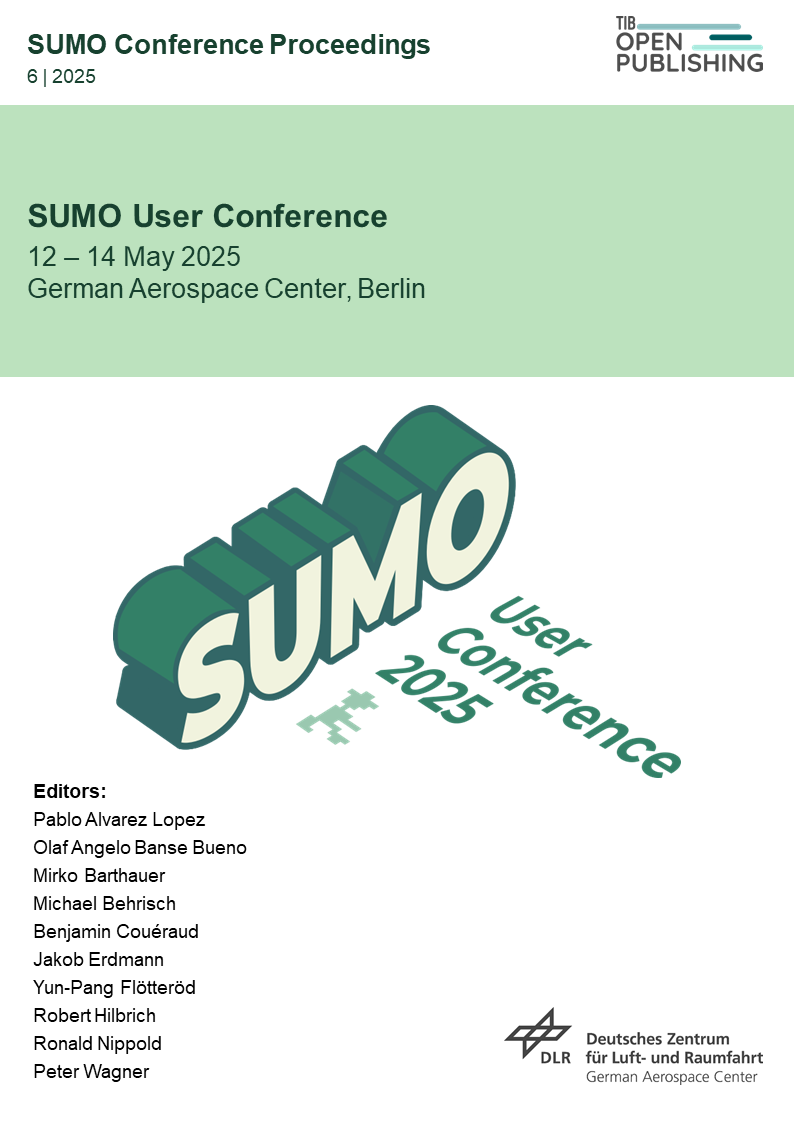HaTS - Hanover Traffic Scenario for SUMO
DOI:
https://doi.org/10.52825/scp.v6i.2605Keywords:
Traffic Scenario, SUMO, Simulation, BicyclesAbstract
Realistic and comprehensive traffic simulations are essential for the effective testing and evaluation of emerging technologies, such as Vehicle-to-X (V2X) communication, and diverse use cases, particularly within complex urban environments. While current traffic scenarios often focus on motorized vehicles, there is a need to address the safety of vulnerable road users (VRUs), such as pedestrians and cyclists. This is especially relevant in light of the European Union's Vision Zero initiative, which aims for zero road fatalities by 2050. Although a few pedestrian-focused scenarios exist, there is no scenario specifically addressing bicycle traffic, despite their status as one of the most at-risk VRUs, with stagnant fatality rates in recent years. To address this gap, this paper introduces the Hanover Traffic Scenario for SUMO (HaTS), a novel traffic scenario including motorized vehicles and bicycles. HaTS provides a detailed and accurate representation of the road network, traffic light systems, and buildings within the city center of Hanover, Germany. A key feature of HaTS is its integration of real-world traffic count data for both bicycles and motorized vehicles, enabling a realistic and representative traffic demand representation. Additionally, a novel metric is employed for the parametrization of the scenario, enhancing the alignment between real and simulated traffic volumes. For the validation we compare the results of the HaTS with the real world traffic counts. HaTS is the first open-source SUMO scenario focused on bicycles, providing a realistic representation of the road network and traffic demand, thereby contributing to the advancement of urban traffic simulations.
Downloads
References
CAR 2 CAR Communication Consortium, "Use Cases". Accessed: January 2025. [Online]. Available: https://www.car-2-car.org/fileadmin/documents/General_Documents/C2CCC_UC_2097_UseCases_V1.0.pdf.
P. A. Lopez, M. Behrisch, L. Bieker-Walz et al., "Microscopic Traffic Simulation using SUMO", in 2018 21st International Conference on Intelligent Transportation Systems (ITSC), 2018, pp. 2575-2582. DOI: 10.1109/ITSC.2018.8569938.
European Commission and Directorate-General for Mobility and Transport, Next steps towards ‘Vision Zero’: EU road safety policy framework 2021-2030, Publications Office, 2020. DOI: 10.2832/391271.
Directorate-General for Mobility and Transport, "2023 figures show stalling progress in reducing road fatalities in too many countries", 2024. Accessed: Nov. 1, 2024. [Online]. Available: https://transport.ec.europa.eu/news-events/news/2023-figures-show-stalling-progress-reducing-road-fatalities-too-many-countries-2024-03-08_en.
S. Lobo, S. Neumeier, E. M. G. Fernandez, and C. Facchi, "InTAS - The Ingolstadt Traffic Scenario for SUMO", SUMO Conference Proceedings, vol. 1, pp. 73–92, Jul. 2022. DOI: 10.52825/scp.v1i.102.
L. Codeca, and J. Härri, "Towards multimodal mobility simulation of C-ITS: The Monaco SUMO traffic scenario", in VNC 2017, IEEE Vehicular Networking Conference, November 27-29, 2017, Torino, Italy, Nov. 2017. DOI: 10.1109/VNC.2017.8275627.
Landeshauptstadt Hannover, "Leitbild Radverkehr: Masterplan Mobilität 2025". Accessed: January 2025. [Online]. Available: https://www.hannover.de/content/download/221834/file/Leitbild-Radverkehr-der-Landeshauptstadt-Hannover.pdf.
L. Codeca, R. Frank, and T. Engel, "Luxembourg SUMO Traffic (LuST) Scenario: 24 hours of mobility for vehicular networking research", in 2015 IEEE Vehicular Networking Conference (VNC), 2015, pp. 1-8. DOI: 10.1109/VNC.2015.7385539.
S. Uppoor, and M. Fiore, "Large-scale urban vehicular mobility for networking research", in 2011 IEEE Vehicular Networking Conference (VNC), 2011, pp. 62-69. DOI: 10.1109/VNC.2011.6117125.
K. Schrab, R. Protzmann, and I. Radusch, "A Large-Scale Traffic Scenario of Berlin for Evaluating Smart Mobility Applications", in Smart Energy for Smart Transport, E. G. Nathanail, N. Gavanas, and G. Adamos, Eds., Springer Nature Switzerland, 2023, pp. 276–287. ISBN: 978-3-031-23721-8.
M. Rapelli, C. Casetti, and G. Gagliardi, "Vehicular Traffic Simulation in the City of Turin from Raw Data", IEEE Transactions on Mobile Computing, pp. 1-12, 2021. DOI: 10.1109/TMC.2021.3075985.
OpenStreetMap, "OpenStreetMap". Accessed: January 2025. [Online]. Available: https://openstreetmap.org.
Google, "Google Maps". Accessed: January 2025. [Online]. Available: https://www.google.com/maps/@52.3626336,9.7227989,119m/data=!3m1!1e3?entry=ttu&g_ep=EgoyMDI1MDEyMi4wIKXMDSoASAFQAw%3D%3D.
German Aerospace Center, "Simulation of Urban MObility". Accessed: Mai 2024. [Online]. Available: https://sumo.dlr.de.
E. W. Dijkstra, "A note on two problems in connexion with graphs", Numerische Mathematik, vol. 1, no. 1, pp. 269-271, 1959. ISSN: 0945-3245. DOI: 10.1007/BF01386390.
S. Krauss, P. Wagner, and C. Gawron, "Metastable states in a microscopic model of traffic flow", Phys. Rev. E Stat. Phys. Plasmas Fluids Relat. Interdiscip. Topics, vol. 55, no. 5, pp. 5597–5602.
N. Ostendorf, K. Garlichs, and L. C. Wolf, "Enhancing Car-Following Models with Bike Dynamics for Improved Traffic Simulation", in 2025 IEEE International Conference on Mobility, Operations, Services and Technologies (MOST).
Downloads
Published
How to Cite
Conference Proceedings Volume
Section
License
Copyright (c) 2025 Nico Ostendorf, Keno Garlichs, Lars C. Wolf
https://creativecommons.org/licenses/by/3.0/de/deed.enAccepted 2025-04-25
Published 2025-07-15
